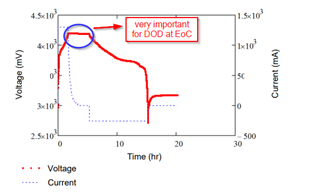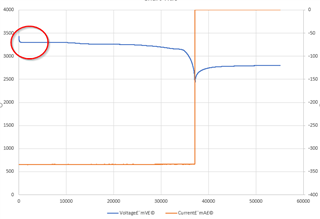Other Parts Discussed in Thread: GPCCHEM
Hello,
What are the update conditions for DOD_EOC? DOD_EOC is always 0, may I ask because it is not updated or the updated value is too large to display? How do I determine if it is updated?
This thread has been locked.
If you have a related question, please click the "Ask a related question" button in the top right corner. The newly created question will be automatically linked to this question.
Hello,
What are the update conditions for DOD_EOC? DOD_EOC is always 0, may I ask because it is not updated or the updated value is too large to display? How do I determine if it is updated?
Hello Sunrain,
DOD_EoC means DOD at end of charge. This parameter gets updated in the data flash when a valid charge termination (VCT) happens. The VCT conditions are stated in section 4.6 Valid Charge Termination in the Technical Reference Manual.
You might also want to visit this FAQ for more insight.
Regards,
Jose Couso
Hi Sunrain,
If DOD at E0C is zero, this implies a wrong ChemID might be matched. Did you match your ChemID correctly? If so, please provide your ChemID.
What is the voltage saved in dataflash (settings) in the parameter Voltage at EoC? This should match to the highest voltage of the ChemID.
Regards,
Jose Couso
Hello Jose,
The chance of updating my original ID is very low, and then it will be updated in real time after I change my ID. However, the original ID used is recommended by GPC-report, and the new ID is not in GPC-report. Which ID should I choose for normal use?
Thanks
Hello Sunrain,
What do you mean by " the new ID is not in GPC-report" ?
You should be using the best matched ID when you ran the GPCCHEM tool. This has to be the latest battery cell you are using.
Regards,
Jose Couso
Hello Jose,
I use GPCCHEM tool to get GPC-report, and I use the best ID in GPC-report for testing, but this DOD_EOC update frequency is relatively low. After I changed the ID test, DOD_EOC could be updated every time, but the changed ID was not in the GPC-report. How do I select an ID in this case? Choose the best ID in GPC-report or choose the new ID?
Thanks
Hi Sunrain,
How did you get this "new ID"? How is it not part of the GPC-report and still give you accurate results?
Please share the following.
1- GPC-report, and input data if you have it.
2- new ID
3- log file which describes a charging/discharging profile of your application
4- configuration file.
Regards,
Jose Couso
Hello Jose,
GPC-report recommended 400, and I changed the 4103 test。I use LFP battery, ID error is relatively large。
Thanks
Chemistry ID selection tool, rev=2.54 Configuration used in present fit: ProcessingType=2 NumCellSeries=1 ElapsedTimeColumn=0 VoltageColumn=1 CurrentColumn=2 TemperatureColumn=3 Best chemical ID : 400 Best chemical ID max. deviation, % : 6.55 Summary of all IDs with max. DOD deviation below 15% Chem ID max DOD error, % Max R deviation, ratio 400 6.55 2.63 445 9.11 0.36 461 11.88 1.33 457 12.07 3 424 12.77 0.64 4167 13.02 0.53 6106 13.9 4.29 4110 14.08 0.84 4166 14.1 0.28 417 14.13 1.24 435 14.2 0.63 436 14.38 2.25 4111 14.61 0.65 3649 14.82 1.7 Max. deviations for best ID is within recommended range. Chosen best chemical ID is suitable for programming the gauge. Selection of best generic ID for ROM based devices like bq274xx Device / Family #1 Generic Chem ID Device/ Voltage/ Chemistry max DOD error, % 312 bq27421-G1B: 4.3V LiCoO2 21.57 354 bq27411-G1C: 4.35V LiCoO2 29.6 3142 bq27421-G1D: 4.4V LiCoO2 35.39 128 bq27421-G1A: 4.2V LiCoO2 46.73 Best generic ID 312 Warning: Generic ID Deviation is so high that it is most likely due to anomaly in the data. Please check that data files have recomended format, units and test schedule Device / Family #2 Generic Chem ID Device/ Voltage/ Chemistry max DOD error, % 354 bq27621: (ALT_CHEM2) 4.35V LiCoO2 29.6 1202 bq27621: (default) 4.2V LiCoO2 29.85 1210 bq27621: (ALT_CHEM1) 4.3V LiCoO2 33.34 Best generic ID 354 Warning: Generic ID Deviation is so high that it is most likely due to anomaly in the data. Please check that data files have recomended format, units and test schedule Device / Family #3 Generic Chem ID Device/ Voltage/ Chemistry max DOD error, % 3230 bq27426: (default) 4.35V LiCoO2 27.43 1202 bq27426: (ALT_CHEM1) 4.2V LiCoO2 29.85 3142 bq27426: (ALT-CHEM2) 4.4V LiCoO2 35.39 Best generic ID 3230 Warning: Generic ID Deviation is so high that it is most likely due to anomaly in the data. Please check that data files have recomended format, units and test schedule Warning: First OCVpoint has non-zero current I= -0.3348 Please make sure you have a 2 hr relaxation period before the beginning of discharge.
Hi Sunrain,
The input data to the GPCHEM tool does not have a charge to full at the beginning. 
Input data
You need to submit a charge to full, relax for 2 hours, discharge to empty and relax for 5 hours. This is probably why your matched ID : 400 is not good for End of Charge detection. It was wrongly matched.
Also, a good matching ID is when the DOD error is below 3%. It looks like the report says that the best ID is 6.55% DOD error deviaton. This is not recommended.
Note:
If this error is not decreased when you submit new data, Then you will need to contact your local TI office or contact a Field Apps Engineer (FAE) if you not already have one. Then, the FAE will submit three of your cells for characterization and essentially we will create an ID for your cell. If this is not done properly, then the gauge will not do proper gauging and a lot of error predictions will happen for SOC, SOH, etc.
Regards,
Jose Couso
Hello Jose,
I don't know what the basis of GPC-report is. I have done a lot of verification, and it should be OK as long as there is discharge-relax data, and the result is the same with other data.
I know that the error of this ID is too large, but there is no other choice at present, and we cannot meet the requirement of TI create an ID at present. According to the current test data, which ID should we choose?
Thanks
Hi Sunrain,
It is recommended to use a matched ID with a DOD error less than 3%.
According to the report, the ID with less DOD error is 400. This one is still not recommended. If you cannot meet our requirements, then it is expected to see errors in gauging. We can only support gauging issues if our procedures are followed.
Regards,
Jose Couso